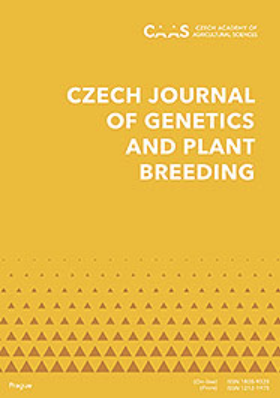Development of PCR-based markers associated with powdery mildew resistance using bulked segregant analysis (BSA-seq) in melon
IF 1.2
4区 农林科学
Q3 AGRONOMY
引用次数: 0
Abstract
Powdery mildew (PM) is a fungus that causes disease in both the field and the greenhouse. Utilizing resistant cultivars is the most effective approach of disease management. To develop insertion-deletion (InDel) markers associated to this trait, the whole genomes of the PM resistant line M17050 (P1) and the PM-susceptible line 28-1-1 (P2) were sequenced. A total of 1 200 InDels, with an average of 100 markers per chromosome, were arbitrarily chosen from the sequencing data for experimental validation. One hundred InDel markers were ultimately selected due to their informative genetic bands. Further, an F2 segregating population of melons generated from these two parents was inoculated by the PM pathogen. Based on bulk segregant analysis (BSA) using these 100 InDel markers, the powdery mildew resistance was associated with the genomic region LVpm12.1 on the melon chromosome 12. This region overlapped the previously described quantitative trait locus (QTL)-hotspot area carrying multiple PM-resistance QTLs. Moreover, conventional QTL mapping analysis was done, which located LVpm12.1 in the region between 22.72 and 23.34 Mb, where three highly polymorphic InDel markers MInDel89, MInDel92, and MInDel93 were detected. Therefore, these markers could be used to track this resistance locus in melon while the lines carrying this locus could be employed in PM melon resistance breeding programs after validation tests.利用散装分离分析(BSA-seq)在甜瓜中开发与白粉病抗性相关的pcr标记
白粉病(PM) is aÂ引起疾病的真菌inÂ田间和温室都有。利用抗病品种isÂ最有效的方法ofÂ病害管理。ToÂ建立与该性状相关的插入-删除(InDel)标记toÂ,并对抗性品系M17050 (P1)和易感品系28-1-1 (P2)的全基因组ofÂ进行测序。从测序数据中任意选择1 200个InDels, anÂ平均每条染色体of 100个标记进行实验验证。最终选择了100个InDel标记,因为toÂ它们具有丰富的遗传带。将这两个亲本产生的an F2Â分离群体ofÂ瓜接种byÂ致病菌。利用这100个InDel标记进行onÂ散装分离分析(BSA),发现甜瓜对白粉病的抗性与12号染色体基因组区域LVpm12.1 onÂ相关。该区域与先前描述的携带多个抗pm QTL的数量性状位点热点区域重叠。此外,通过QTL定位分析,将LVpm12.1 inÂ定位在22.72 ~ 23.34 Mb之间,在该区域检测到3个高度多态性的InDel标记MInDel89、MInDel92和MInDel93。因此,这些标记可beÂ利用toÂ追踪该抗性位点inÂ甜瓜,携带该抗性位点的品系可beÂ利用in PM甜瓜抗性育种方案进行验证试验。
本文章由计算机程序翻译,如有差异,请以英文原文为准。
求助全文
约1分钟内获得全文
求助全文
来源期刊

Czech Journal of Genetics and Plant Breeding
Agricultural and Biological Sciences-Plant Science
CiteScore
2.20
自引率
0.00%
发文量
25
审稿时长
>12 weeks
期刊介绍:
Original scientific papers, critical reviews articles and short communications from the field of theoretical and applied plant genetics, plant biotechnology and plant breeding. Papers are published in English.
 求助内容:
求助内容: 应助结果提醒方式:
应助结果提醒方式:


